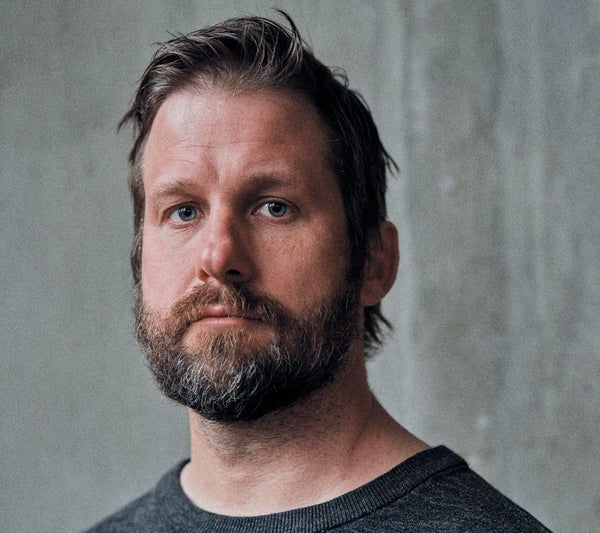Contributors to Scientific American’s April 2025 Issue
Writers, artists, photographers and researchers share the stories behind the stories

Tristan Spinski
A Complex Diagnosis
The medium of photography is defined by its limits: shutter speeds, the available lighting, the background. “It’s just this slight snapshot” of the world, says photographer Tristan Spinski (above). He sees his art as “an exercise in subtraction” and strategic ambiguity, and he “allows space for the story to pour in and fill those gaps.” This feature article by writer Paul Marino details the author’s quest to understand the cause of a lifelong secret, a repeated motion of his hands he calls “motoring.” Spinski traveled from his own home in coastal Maine to Marino’s in New Hampshire, where he used long exposures to capture the essence of Marino’s motoring in still images.
Over the past 20 years Spinski has learned that he’s most passionate about depicting things “on the edges of appreciation” that we see but pay little attention to. For a recent project, he spent three years photographing vernal pools, seasonal bodies of water that vary in size from a puddle to a pond. These networks of ephemeral pools are like “neural hubs” of a forest from which “life sort of blooms out,” he says. “To me, now, the puddle in the forest is essential”—a discovery that also taught him about the fascinating stories one can find in their own backyard.
On supporting science journalism
If you’re enjoying this article, consider supporting our award-winning journalism by subscribing. By purchasing a subscription you are helping to ensure the future of impactful stories about the discoveries and ideas shaping our world today.
Kathryn Zurek
The Hidden World
Kathryn Zurek became a theoretical physicist because she wanted to understand, mathematically, how the universe works. “It appealed to me that it was hard,” she says. Zurek ultimately decided to study one of the hardest open questions in the field: What is dark matter made of? In our cover story, she explains the “hidden valley” theory of dark matter she helped to pioneer, which posits that there’s an entire world of dark particles out there, invisible to the eye.
Zurek always searches for simple, physical analogs when trying to puzzle out a problem. “I think in very physical terms,” she says, an approach that theoretical physicist Richard Feynman was also known for. “He could explain just about anything in terms of an electronic circuit,” Zurek says. Her theory of hidden valleys has been influential in the field of dark matter, and now she’s bringing her physical approach to another big open question in physics: How does gravity fit into quantum mechanics? “I’m an outsider in that community,” she says, but if the sets of ideas she has brought to the field are realized in nature, “it will be precisely because I’ve come into a new field with a different way of thinking about those problems.”
Diana Kwon
A New Look at Schizophrenia
While pursuing a master’s degree in neuroscience, Diana Kwon began reporting science and technology stories for her school’s student newspaper. She had so much fun that she decided to make it her career. “I love science journalism,” she says. When cool discoveries happen, “we get to see the exciting part of that whole [scientific] process.” Now, as a Berlin-based journalist, Kwon focuses on neuroscience. In her article for this issue, she explores a new understanding of the complexities of schizophrenia. Recent findings have complicated what she calls the “big narrative” of schizophrenia’s causes—and have pointed to the immune system’s role in a subset of cases.
Schizophrenia is one of many conditions that may arise from both the mind and the body, Kwon says. She often is drawn to these boundary-defying health stories and has covered the brain-body connection in functional neurological disorders, heart conditions and even cancers. When treatments and diagnoses are siloed into one medical field, patients can lose out. “Increasingly,” Kwon says, “there’s a realization, among both clinicians and researchers, that these distinctions we have between disciplines are artificial and need to be broken to better serve people across all different communities.”
Mark Witton
Gladiators of the Mesozoic
Mark Witton has been drawing Triceratops and Stegosaurus since he was a kid. Now it’s basically his full-time job. As a paleontologist, he has found himself immersed in the field of paleoartistry, where he uses scientific research to make educated guesses of what these long-lost creatures looked like. Those guesses have changed a lot over the decades, and dinosaur reconstructions today look very different than they did when Witton was younger. For this issue’s feature on armored dinosaurs by Michael B. Habib, Witton was tasked with creating side-by-side comparisons of old versus new looks for Stegosaurus and Triceratops, along with a “new kid on the block,” the armored dinosaur Borealopelta.
There is no set academic path for someone who wants to become a paleoartist—Witton has had to learn as he goes. For his Ph.D. thesis, he studied the anatomy of avian pterosaurs, which are “some of the most ridiculous-looking animals you can imagine,” he says. He can now stare at a fossil skeleton for hours and map out the muscle groups in his mind. (Museums “have to kick me out,” he says.) “When you’re drawing a dinosaur, it is in essence drawing from one’s imagination,” even when the image is grounded solidly in fossil data. Yet “as outlandish as dinosaurs were, they were still animals living on the same planet that we do,” Witton adds. “We must be careful not to make them look like aliens. They need to have an element of recognizability to them.”










